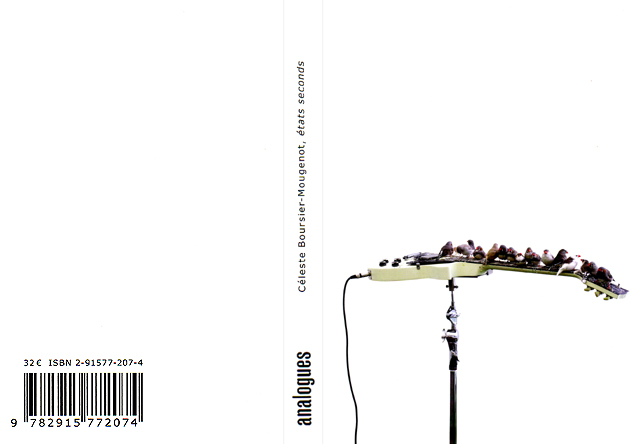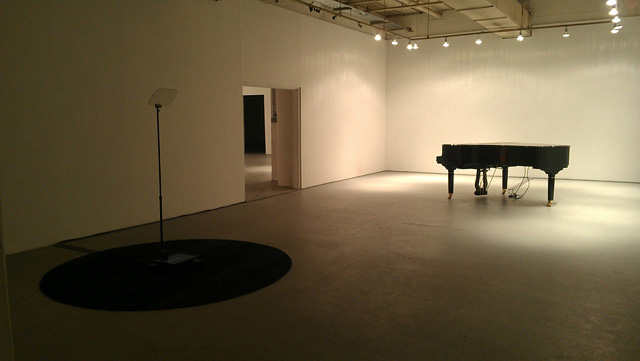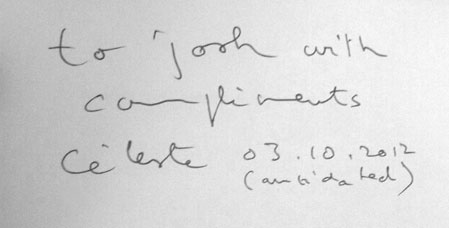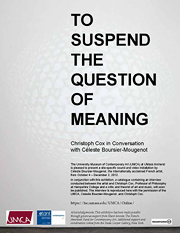Thursday, October 11th, 2012
Céleste Boursier‐Mougenot
at UMCA Oct 4 – Dec 2 2012
To Suspend The Question of Meaning
Christoph Cox in Conversation
with Céleste Boursier‐Mougenot
The University Museum of Contemporary Art
(UMCA) at UMass Amherst

Cover: 2008 catalogue; itself an adapted work by Céleste Boursier‐Mougenot, Available through
Paula Cooper Gallery, extended sound samples: http://www.analogues.fr/indexinprogress
Artist Organized Art
The University Museum of Contemporary Art (UMCA) at UMass Amherst is pleased to present a site-specific sound and video installation by Céleste Boursier‐Mougenot, the internationally acclaimed French artist, from October 4 – December 2, 2012. In conjunction with this exhibition, a catalogue containing an interview conducted between the artist and Christoph Cox, Professor of Philosophy at Hampshire College and a critic and theorist of art and music, will soon be published. The interview is reproduced here with the permission of the UMCA, Céleste Boursier‐Mougenot, and Christoph Cox. https://fac.umass.edu/UMCA/Online/ Acknowledgements: This exhibition has been made possible through generous support from Etant donnés: The French-American Fund for Contemporary Art. Additional support and coordination comes from the Paula Cooper Gallery, New York.
The Entire Interview: (Read It Here)
EXCERPTS:
Christoph Cox: You began your career as a musician and composer. What prompted your move into sound installation and the context of the visual arts?
Céleste Boursier‐Mougenot: I’ve always been immersed in the visual arts and aesthetic considerations because my family is very connected to the arts. My great grandfather was a passionate landscape photographer who worked with daguerreotypes. His son, my grandfather, was a painter and illustrator who made some animated films. My father made stained glass for churches, made sculpture and mosaics for public art projects, and later became a sort of garden historian. My parents considered all forms of art and literature to be really important. Their artist and writer friends often visited and stayed with us.
The concept of space (broadly considered) was also a recurrent interest for all of us. One of my brothers, who was interested in mapping, studied engineering and topographical geography. Another brother is a landscape architect. My mother worked as a sociological urbanist. So it’s also quite natural that I’ve considered the notion of space and integrated it into my musical practice.
At home, we listened to all kinds of music (classical, ethnic, rock and pop, experimental, free jazz etc.) and went to musical performances, art exhibitions, and movies every week. I grew up without a TV. When I was about twenty years old and got my own apartment, I bought my first TV. Instead of working on my music projects, I spent so much time watching it at night that I finally threw it away. I kept in the back of my mind that some day I would do a project that would reverse the passivity of TV watching and pull viewers somewhere else, into a space where they have to identify what they are watching. (This eventually resulted in zombiedrones. Many of my works have roots in questions, thoughts, or ideas I had a long time ago. It took me more than 15 years to get the means to start my index piano project.)
CC: When you transpose or transduce one form or media into another, the two forms have to be linked closely enough that the transposition doesn’t seem arbitrary; but they also have to be distant enough so that something surprising or enigmatic is revealed in the process. How do you balance between these two constraints?
CBM: Yes, you’re right, constraint is the master word of my practice. Usually I restrict myself to one material and one process to extract the sound or musical field of the work. The architecture of the presentation space is also an effective constraint by which works can be transformed. The Amherst exhibition is the first to present a set of my works in the same space.
CC: Many of your works are generative structures that establish a situation and then leave it to operate on its own. This makes me think of experimental composers such as Steve Reich (e.g., Come Out) and Alvin Lucier (e.g., I Am Sitting in a Room) who, in the 1960s and 70s, developed an interest in generative music. Are those figures influences for you?
CBM: I’ve been influenced by so many artists’ works that to speak about these ones instead of others seems to me unfair. I think that the domain of influences can remain private. Research into causality or paternity doesn’t really interest me. (I have my own father and am myself the father of four kids!) The feedback effect in my practice in a way tries to disrupt this line of thinking. It seems to me that concrete stories or memories about the works are often more interesting than theoretical references. It’s also that I’ve been disappointed by certain artists who constantly refer to established works, but whose own work is not as interesting as their talk about it. If an art critic or historian sees a correlation, that does not disturb me. But I like it when people can havean aesthetic experience without reference to art history.
CC: The idea that there is music waiting to be revealed everywhere seems to me to connect with a recent artistic and curatorial interest in animism and the life of things.
CBM: I often say that I’m a techno-animist, and that my work is dedicated to the “living.”

Céleste Boursier‐Mougenot, index, v.4, 2005/2009,
Pleyel piano P190 with PianoDisc system,
computer and software,
74.5 x 59.5 x 40.5
Céleste Boursier‐Mougenot is an internationally acclaimed French artist whose innovative work merges the realms of the musical and the visual. A native of Nice, Céleste Boursier‐Mougenot was born in 1961 and currently lives and works in Sète, France. His work has been exhibited in venues such as the capcMusée, Bordeaux, France (1997); the ITT InterCommunication Center, Tokyo (2000); the Herzliya Museum of Art, Israel (2001); Pinacoteca Sao Paulo, Brazil (2009); Musée Chagall, Nice (2009); and the Henry Art Gallery, Seattle (2010);and in the group exhibition Notations: The Cage Effect Today at Hunter College Art Gallery in NYC (2012); Boursier‐Mougenot presented solo exhibitions at the Barbican Center in London, the Queensland Art Gallery in Australia, PS1 (MoMA), NYC, and FRAC Champagne- Ardenne in Reims, France. He recently took part in the 3rd Moscow Biennaleand and was a nominee of the Marcel Duchamp Prize (2010). His work is in major public and private collections around the world, including the Israel Museum, Jerusalem; the San Diego Museum of Contemporary Art, La Jolla, CA; the Centre Pompidou, Paris; the Fonds National d’Art Contemporain, Paris; MONA (Hobart, Tasmania); the Queensland Art Gallery, Brisbane, Australia; and La Maison Rouge, Paris.
Christoph Cox is a critic, theorist, and curator of art and music. He is Professor of Philosophy at Hampshire College where he teaches and writes on contemporary European philosophy and contemporary art and music. He is also on the faculty at the Center for Curatorial Studies, Bard College and is currently at work on a philosophical and historical book about sound art and experimental music.
List of Works Discussed: (Full Interview)
untitled (1997 – ): In an inflatable pool half-filled with water float several dozen pieces of everyday crockery: different sorts of bowls, plates, china, and stemmed glasses. An immersed water pump produces a gentle current that causes the objects to bump into one another, producing sound on contact. To favor the resonance of the objects, the temperature of the water is maintained at around 30 degrees Celsius.
from here to ear (1999 – ): The exhibition space is turned into an aviary filled with live finches. Several electric guitars plugged into amplifiers and placed horizontally on chrome stands serve as perches for the birds, whose movements excite the guitar strings. Viewers are invited to walk through the space amidst the birds, guitars, and guitar cases filled with birdseed and water.
videodrones (2000-2002): Several video cameras placed outside the exhibition space monitor passing vehicles and pedestrians, producing a real-time stream of images projected inside the gallery. The video output of these cameras is fed into an audio amplifier to produce a continuous hum that is modulated by the luminosity of the camera images and the speed and size of the objects that cross their frames.
harmonichaos (2000-2006): Various small diatonic harmonicas are inserted into the nozzles of thirteen vacuum cleaners, which produce sound via suction. Each vacuum cleaner is fitted with a microphone, a guitar tuner, and an on-off switch governed by the tuner. The multiple sound sources confuse the tuners, which turn the vacuum cleaners on and off in unpredictable ways.
flamByframe (2006): This video loop presents a blowtorch flame altered by the camera filming it. To construct the piece, the video image of the flame was converted into an audio signal that was then sent through a subwoofer that excited the air and eventually blew out the flame. The silent video presents the slowed movement of the flame during the minute before it is extinguished.
index and indexes (2006 – ): A piano is played by a software system that, in real time, translates text (or other information) into a musical score. In earlier iterations of the project, the text was supplied by computer keyboards in the vicinity: the typing of museum staff, patrons at an internet café, etc. For the exhibition at UMCA, the piano score will be a translation of stock market data from business news and financial information websites.
recycle (2006): Cameras focused on a tree outside the exhibition space detect the subtle movements of leaves that rustle in the wind. A modulator registers this movement and uses it to direct the action of nine air fans affixed to a wall inside the gallery. A video image of the exterior foliage is visible on a small surveillance monitor placed near the fans.
scanner (2006): Directed by air flowing from a fan placed on the floor, a helium balloon drifts around a gallery space encircled with loudspeakers. Attached to the balloon is a wireless microphone that generates feedback when it approaches one of the speakers. This feedback is transformed in real time by a sound processor that eliminates its stridency and translates it into a form of aleatoric music.
virus (2006): This video loop consists of a continuously morphing image produced by a video feedback system: a video camera placed facing a monitor that reproduces the images filmed by the camera. The largely white image is projected onto a white wall and adjusted to the limit of visibility.
zombiedrones (2008): A plasma screen is placed in front of a leather sofa, encouraging audience members to sit down, watch TV, and change the channels as they like. But this TV encrypts the images, editing them so that only the moving elements of each frame appear on screen, while the non-moving elements disappear. The image is thus emptied of its message, leaving only ghostly figures. The humming soundtrack is the result of a translation of the images into sound.
fisheyedrones (2011): Hundreds of goldfish are placed in a tank in the gallery space. Their movements are filmed and projected onto a screen; and these same movements are registered by a computer program that translates them into sound.


